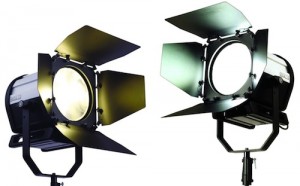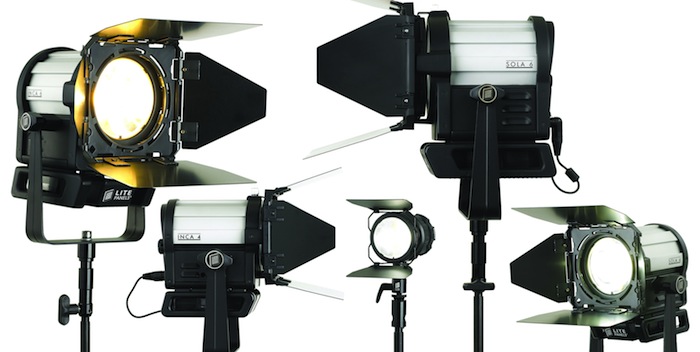Litepanels LED Fresnels
Over the past few months I have been using the line of Sola LED lights from Litepanels more and more.
For those of you who were at NAB, you may have seen demonstrations of their new LED Fresnel series. At that time they were showing off their Sola 4, Sola 6, and their Sola ENG Flight Kit – which is a lighting kit made up of three of their Sola ENG size fresnels. For those of you who aren’t familiar with the Fresnel series that Litepanels has developed, it is a series of DMX controllable lights (which means they can be put on any standard studio lighting grid and controlled remotely), that incorporates LED technology behind a fresnel lens, which gives you soft, focusable light that is that standard among filmmaking lights, such as those made by Mole-Richardson and ARRI.
Like the other lights in the Litepanels line, these lights offer 0%-100% dimming with no noticeable color shift, are cool to the touch, and are flicker free at any shutter speed and/or frame rate.
However one of the main advantages to these lights is their low power draw, relative to their high lumen output. For instance, the Sola 4 has a 39W draw with an output comparable to that of an HMI (filament based daylight-balanced light) with a 125W draw. That adds up to an almost 70% reduction on power consumption for the same amount of lighting. Because of this you can power multiple versions of these lights off a single outlet – or off a battery which is a SIGNIFICANT factor (more to come on that in my next post.) Anton Bauer has numerous accessories that interface with the DC power inputs of these lights, and because of the low power draw – a hefty Anton Bauer, such as the Dionic HC or Dionic HCX can power the smaller LED lights for hours.
This truly opens up the portability of fresnel lights in a big way. For one, you no longer need noisy/cumbersome generators to power them. For instance, Prior to LED technology finding its way behind a fresnel lens, without a put put (or greater) generator you simply wouldn’t be able to use this type of lighting out in the field. Now productions can leave generators behind in certain situations and bring directional lights out with them into the field. That being said, these lights are simply not powerful enough to light entire scenes outside in bright daylight conditions – for that you will still need larger solutions (10k’s, 18k’s, HMI balloons, etc.) that require generator power. If you’re shooting in overcast weather, or indoors – these really are close to the perfect solution. These lights are ideal for documentarians looking for nice interview lighting on the fly or for DPs who need to add some kick and accent light. They also provide a great solution for shooting indoors and for those of us who need to fly with our lighting kits. For one, there is no concern with blowing fuses or destroying power outlets when shooting in an apartment, home, or business that was not designed to power high-wattage lighting, and second these lights are very light relative to many other systems out there. The fact that they are using LED light sources also makes them much more durable and resistant to impact damage – relative to the traditional filament based lights.
 The first phase of this release included the Sola ENG. A small, camera-top, or stand mounting light with a 3" fresnel lens. Recently, they released their Sola ENG Flight Kit, which includes three of these Sola ENG fresnel lights with all of the accessories and stands you would need to use them. (Full specs on the ENG can be found HERE). This is FANTASTIC little kit to travel with and comes in a carry-on size Pelican case. We used this kit for our Moto Art piece and got beautiful results.
The first phase of this release included the Sola ENG. A small, camera-top, or stand mounting light with a 3" fresnel lens. Recently, they released their Sola ENG Flight Kit, which includes three of these Sola ENG fresnel lights with all of the accessories and stands you would need to use them. (Full specs on the ENG can be found HERE). This is FANTASTIC little kit to travel with and comes in a carry-on size Pelican case. We used this kit for our Moto Art piece and got beautiful results.
There are two big brothers to these smaller units in the the Sola series: the Sola 4 and Sola 6 mentioned above. These are 4" and 6" versions (respectively) of a daylight-balanced fresnel light. The Sola 4 has a 39W draw with the equivalent output of a 125W HMI. The Sola 6 has a 104W draw, with the equivalent output of a 200W HMI. Recently, Litepanels announced a new fixture to this line, the Sola 12 (pictured left), which as the name suggests is a 12" version of the daylight-balanced fresnel. It will have a 350W draw and, according to Litepanels’ preliminary testing, will have a light output approaching that of a 2000W incandescent tungsten light. That’s pretty awesome! (Full specs on these lights can be found here – SOLA 4, SOLA 6, SOLA 12).
Litepanels has more recently offered Tungsten versions of the above lights in their Inca series. The sizes are the same, 4", 6", and 12". The Inca 4 has a 39W draw and the output of a 250W incandescent fresnel. The Inca has a 104W draw and the output of a 350W incandescent fresnel. Likewise, the Inca 12 (also pictured left) will have a 350W draw and an approximately 2000W incandescent fresnel equivalent output.
I’ve been waiting for Litepanels to make the move toward more directional lighting as with this Sola and Inca series for awhile. As many of you know I’m a big fan of their 1X1 LED lights and have been using those for over 3 years now on almost all of my shoots. This new series will allow us to move towards the next phase of lighting with lighter, more durable lights (that travel much more easily) that are significantly more energy efficient and able to run off of much smaller power sources and batteries, as opposed to generators, and that won’t burn your hand off if you touch them without a glove. All this without any loss in the quality of light that we’re used to – that’s what I call forward progress!














Hi Vincent, your blog is such a treasure trove of info! I was just researching Litepanels and when I came to your blog, I had to do a double take since I see you just wrote up an entry on it!
I’m looking to replace another LED unit that has a strong ugly green shift and was looking to the Sola ENG as a great candidate. LEDs aren’t known for their high CRI and I find it concerning that the only manufacturer that I know of that publishes a CRI for their LED light is Kino Flo (CRI 95 for their new Celeb panel).
Have you noticed any green/magenta spikes with the Sola’s and do they mix well with 5600K fluorescent fixtures and HMI’s? Also, has the fans in them ever been a problem in terms of audio?
Thanks for being so willing to share with us!
Vincent Laforet Reply:
October 18th, 2012 at 9:30 pm
I’m uncomfortble making definite statements as I haven’t done scientific side by side test w/ a color meter for example. But I definitely haven’t had any issue yet.
Great lights, I agree for using them regularly… but at that price, it’s totally unacceptable that they only have a 1-YEAR warranty!!
How do you find the color reproduction? Do you find any green tints compared to shooting with a traditional tungston light? What about the quality, does it act different than a tungston fresnel? Thanks for the informative post!
Vincent Laforet Reply:
October 18th, 2012 at 9:28 pm
I’ve only worked w/ the daylight version. We didn’t see any shift w/ good gel use.